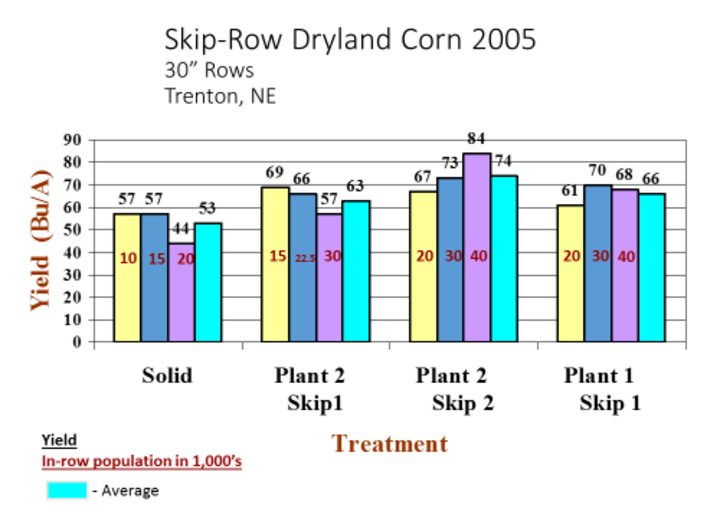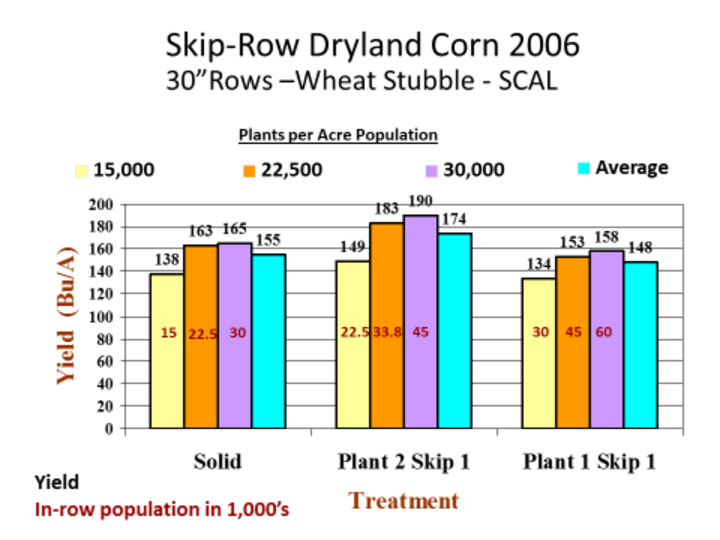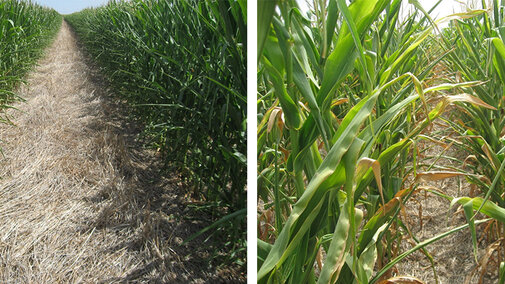The idea behind skip-row planting is to prevent corn plants from using all of the available soil water too early in the growing season. Because water in the soil between widely spaced rows cannot be reached by the crop until later in the season, water is available to plants in July and August. Corn is very sensitive to drought in the silking to blister stages of development, which occur in July and August.
More articles in this series
Skip-row corn research began in Nebraska in 2003. In this first trial, all rows of corn were planted and then plants were removed to reduce population, or one or two rows were removed on July 2. The growing season precipitation, from Sept. 1, 2002 to Aug. 31, 2003, was 17.88 inches. The last 30 years average precipitation was 20.43 inches. A breakdown of yields from this trial, which included four replications, follows:
- Control (19,5000 population): 41 bu/ac
- Removing approximately every third plant (14,700 population): 41 bu/ac
- Removing every other plant (11,200 population): 45 bu/ac
- Series of two rows of corn followed by one row removed (equivalent to 13,800 population): 48 bu/ac (17% above the control)
- Series of two rows of corn with the next two rows removed (equivalent to 9,500 population): 54 bu/ac (32% above the control)
Normally, by July 2, corn will have used 6 inches of soil water. Yields may have been further increased if the skip treatments had been implemented earlier in the season.
Additional research was then conducted at several locations in Nebraska, Kansas and Colorado. The treatments consisted of three corn populations and four skip-row configurations. The skip-row configurations were:
- No skip-row (control)
- A skip-row for every two planted rows: plant two, skip one
- Two skip-rows alternating with two planted rows (double skip): plant two, skip two
- A skip-row alternating with a planted row (single-skip): plant one, skip one
The results of the 2004 skip-row dryland corn plots at North Platte are shown in Figure 1. These are with very favorable precipitation during the growing season. June precipitation was 35% above average, July was 88% above average, and August was average. Even with this very favorable precipitation, the plant two, skip one configuration out-yielded the solid planting at all population levels.
The results of a dry year in 2005 at Trenton are shown in Figure 2. The highest yield was in the plant two, skip two treatment at the high plant rate of 20,000 plants/acre (40,000 in the planted rows). The yield was 84 bu/ac vs 44 bu/ac at that planting rate in 30-inch rows.
At a higher precipitation area, the South Central Ag Lab (SCAL) near Hastings, 30-inch rows on solid corn planting were compared to two skip-row planting configurations (Figure 3). The highest yield was in the plant two, skip one treatment at a population of 45,000 plants/acre in the planted rows or 30,000 plants/acre if you include the skip row. Apparently, the solid planting suffered more drought stress than the plant two, skip one configuration. The most economical planting rate is probably 22,500 plants/acre for both the solid planting and plant two, skip one (33,800/acre in planted rows). At that planting rate, there is a 20 bushel yield advantage to the plant two, skip one planting configuration.
Table 1 lists the yield possibilities for skip-row corn in a plant two, skip one configuration and Table 2 lists yield possibilities for a plant two, skip two configuration. In an Iowa study where six rows of corn were planted next to six rows of soybeans, the outside corn rows yielded 20% more on average. If we use 0.5 lb ears as the standard, we would expect the rows in a skip-row to be at least 0.6 lb ears, maybe 0.62 lb ears, since there is no corn row next to them.
Also see Implementing Skip-row Planting in this week's CropWatch for recommendations on planting and fertilizing skip-row corn.



| Planted pop. in 2 rows/ac | Stand pop. in 2 rows planted/ac | Stand pop. in 3 rows (2 rows planted)/ac | Ear wt/lb yield/bu/ac | Ear wt/lb yield/bu/ac | Ear wt/lb yield/bu/ac | Ear wt/lb yield/bu/ac |
|---|---|---|---|---|---|---|
| 20,000 | 18,000 | 12,000 | 0.5 = 86 | 0.6 = 103 | 0.62 = 106 | 0.7 = 120 |
| 24,450 | 22,000 | 14,667 | 0.5 = 105 | 0.6 = 126 | 0.62 = 130 | 0.7 = 147 |
| 28,900 | 26,000 | 17,334 | 0.5 = 124 | 0.6 = 149 | 0.62 = 154 | 0.7 = 173 |
| 33,333 | 30,000 | 20,000 | 0.5 = 143 | 0.6 = 171 | 0.52 = 177 | 0.7 = 200 |
| Planted pop. in 2 rows/ac | Stand pop. in 2 rows planted/ac | Stand pop. in 4 rows pop. (only 2 planted)/ac | Ear wt/lb yield/bu/ac | Ear wt/lb yield/bu/ac | Ear wt/lb yield/bu/ac | Ear wt/lb yield/bu/ac |
|---|---|---|---|---|---|---|
| 20,000 | 18,000 | 9,000 | 0.5 = 64 | 0.6 = 77 | 0.62 = 80 | 0.7 = 90 |
| 24,450 | 22,000 | 11,000 | 0.5 = 79 | 0.6 = 94 | 0.62 = 100 | 0.7 = 110 |
| 28,900 | 26,000 | 13,000 | 0.5 = 93 | 0.6 = 111 | 0.62 = 120 | 0.7 = 130 |
| 33,333 | 30,000 | 15,000 | 0.5 = 107 | 0.6 = 129 | 0.62 = 140 | 0.7 = 150 |
Advantages of Skip-row, No-till Planting
No-till offers several advantages with appropriate levels of crop residue:
- Greater soil water savings: After base needs are met (10 inches of soil water) corn yields can increase 12.5 bushels per acre with every one-inch increase in soil water available to the crop.
- Faster soil water infiltration. (Maintaining a good crop residue cover is key to its success.)
- Higher yields.
The greatest benefits can be derived from ecofallow corn. Ecofallow is the period between winter wheat harvest and planting a no-till crop the following spring into the undisturbed winter wheat stubble.
Yield of the following corn crop increases with increasing wheat crop residue levels: 6,000 pounds residue per acre, approximately 60 bushels of grain per acre. Using stripper heads for harvesting the winter wheat has increased crop residue levels and improved corn yields the following season.
Potential Disadvantages of Skip-row Planting
- Yields will be limited to approximately 120 bu/ac (plant two, skip two) and 160 bu/ac (plant two, skip one). This is not a likely deterrent in western Nebraska.
- Crop insurance may not be available or only partially available.
- The Farm Service Agency may not count all acres as planted acres.
- Fields may be more attractive to corn borer because they are greener and healthier. (Plant Bt corn hybrids.)

